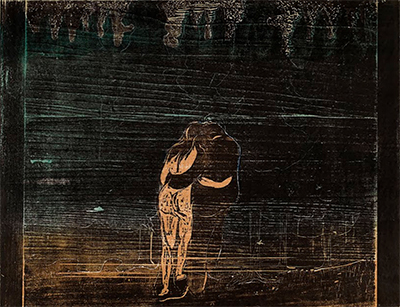Edvard Munch produced several woodcuts on this same theme, with a couple starting off into the forest. The first was in 1897, with the followup in 1915. He would produce countless numbers of prints from these designs, constantly tweaking the production in order to give different results.
The example found before us here actually leaves very little detail of the forest, but in others there were fully formed tips of trees that fill the upper edge of the piece. Munch felt very connected to nature and would have enjoyed the idea of producing a picture of trees upon wood. He could essentially feel the contours and natural imperfections of this medium whilst working upon it, and he also worked on stone from time to time as well. Most only known him as an oil painter, but actually he regularly experimented with other mediums, with many lithographs from his career now being found at the Munch Museum in Oslo, Norway. When working with woodcuts he would tend to keep detail to a minimum, concentrating on simple forms and making use of the expressive nature of his style that persisted throughout all materials that he used.
The composition of To the Forest, sometimes known as Towards the Forest, simply features an embracing couple starting off into the wilderness. Tips of trees indicate the presence of a forest, but the rest of the scene is left entirely blank. We can of course fill that in with our imagination, as well as our understanding of the artist and how he often worked at night or in relatively poor light. Couples embracing are found throughout his career, normally representing love. In this case he provides much more detail for the female figure, allowing the male to merge into her form and also the background behind. This would have served a symbolic purpose, as with many of Munch's other expressionist paintings. It is believed that around 50 prints were made from these woodblock designs, with one alone receiving an auction price of £375,000. Most remain in national galleries and therefore are unlikely to ever come up for sale.
Those looking to understand more about Munch woodcuts should also check out Two Heart, which features a similarly dark but intriguing atmosphere. There was also a catalogue raisonne constructed of the artist's career that will no doubt draw your attention to many more of his work within this medium that you were entirely unaware of before. It appears to be the most comprehensive documentation of his life's achievements so far, and was a huge undertaking considering the amount of work that this artist produced across his lifetime, as well as the sometimes poor documentation that came with many of them, particularly the lesser known and smaller pieces that he tended to consider more of an experimentation than genuine artworks to be displayed and sold.




